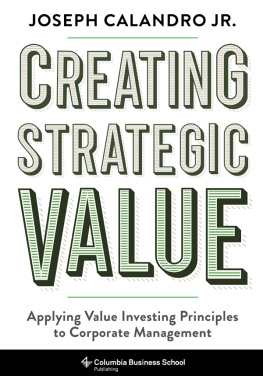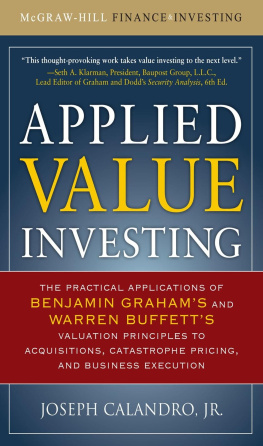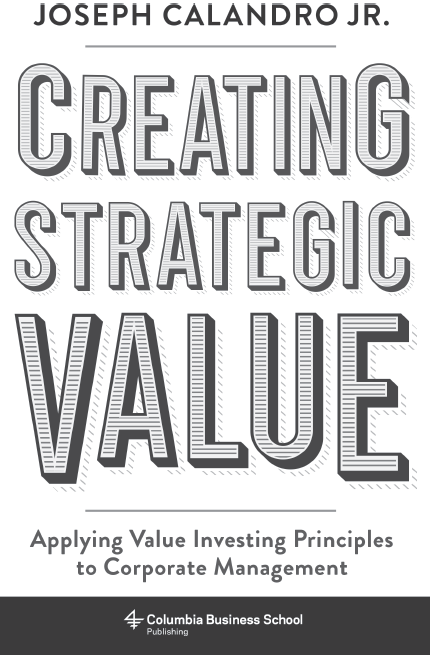Table of Contents
Creating Strategic Value
Columbia University Press
Publishers Since 1893
New York Chichester, West Sussex
cup.columbia.edu
Copyright 2020 Joseph Calandro Jr.
All rights reserved
E-ISBN 978-0-231-55067-3
Library of Congress Cataloging-in-Publication Data
Names: Calandro, Joseph, author.
Title: Creating strategic value: applying value investing principles to corporate management / Joseph Calandro Jr.
Description: New York: Columbia University Press, [2020] | Includes bibliographical references and index.
Identifiers: LCCN 2019057473 (print) | LCCN 2019057474 (ebook) | ISBN 9780231194143 (hardback) | ISBN 9780231550673 (ebook)
Subjects: LCSH: Investment analysis. | CorporationsValuation. | Value investing.
Classification: LCC HG4529 .C36 2020 (print) | LCC HG4529 (ebook) | DDC 658.15dc23
LC record available at https://lccn.loc.gov/2019057473
LC ebook record available at https://lccn.loc.gov/2019057474
A Columbia University Press E-book.
CUP would be pleased to hear about your reading experience with this e-book at .
Cover design: Noah Arlow
For Terilyn, again and always, and to the memories of Bruce M. Bickley and Martin J. Whitman
Contents
PREFACE TO PART 1
Theory
1
Value Investing and Corporate Management: Overview
2
Corporate Strategy and the Margin of Safety
3
Cash and Competitive Advantage
4
Corporate Management and Security Analysis (including an interview with Seth A. Klarman)
5
Value Creating Corporate Management: Henry E. Singleton
6
Managerial Rationality
7
Corporate Management and Modern Security Analysis (including an interview with the late Martin J. Whitman)
8
Value Realization Is The Most Important Thing
PREFACE TO PART 2
Practice
9
Value Realization at GEICO
10
Value Realization at GTI Corporation
11
Value Realization at the Union Pacific
EVER SINCE BENJAMIN Graham wrote about Mr. Markets mood swings and sentimental ups and downs, astute and successful investors have practiced the art of distinguishing price from value. Graham and Dodd advised investors in their seminal book Security Analysis that a financial asset should be purchased when its market price is significantly below its intrinsic value. This celebrated principle, known as the margin of safety, has guided the investment decisions of many value investors in the past and will continue to do so for many years to come. But financial assets are not the only assets where this principle is applicable. Indeed, many strategic decisions in corporate finance, from takeovers to corporate risk management, can benefit from the insights that one finds in Security Analysis and The Intelligent Investor. Surprisingly, very few books document these corporate finance applications in a comprehensive manner, with the exception of Joseph Calandros Applied Value Investing, which covered several specific applications. His new book, Creating Strategic Value, more comprehensively illustrates the application of value investing principles in many areas of corporate management, ranging from the use of excess cash to stock buybacks and acquisitions.
Value investing and its underlying principles can influence corporate management in two separate ways or channels. On the one hand, value investors are active investors, and there are many examples of how they can influence the management of corporations. This channel is more frequently discussed. For example, Benjamin Graham himself knew the importance of shareholder activism (beautifully illustrated by Jeff Gramm in Dear Chairman), and Mario Gabellis analysts at GAMCO constantly grill corporate managers on how they allocate capital within the firm. It is well known that Warren Buffett has long advocated a strategy of buying companies with a strong management team, which shows how corporate management can be a prerequisite for an effective value investing strategy. These examples illustrate how value investors, including activist investors, can guide corporate managers to create shareholder value.
But there is another channel, perhaps a road less frequently travelled, where Calandros Creating Strategic Value makes a much-needed contribution. Here we ask ourselves whether and how a CEO can proactively create stakeholder value by applying the fundamental principles of value investing to how the corporation is managed and how corporate strategy is defined and implementedand not just react to activist investors. Few authors have addressed this question until now, and Calandro shows us how successful CEOs have, and should, carry out this task.
Joseph Calandro is a skilled practitioner in the art of corporate management and corporate strategy. He has many years of experience in corporate consulting and has published his keen observations in many papers. Creating Strategic Value brings together much of his earlier research in one unified compendium. Calandro is also a keen observer of the changes that have taken place since Graham and Dodd first emphasized tangible assets and net-net stocks. Many large corporations today have huge intangible assets and many others have very large amounts of cash invested in hedge funds and private equity. This book provides useful perspectives on these changes. Yet another remarkable feature of the book is that several chapters demonstrate how famous investors such as Seth Klarman and Lee Cooperman, and famous CEOs such as Henry Singleton and Prem Watsa, have implemented the insights of value investing. There is a delightful conversation with Seth Klarman, too. The book is written in a style that allows readers with little technical knowledge of finance and business to understand the key concepts. This approach will help the book reach a larger audience.
The Gabelli Center at Fordham University is happy to say that Joseph Calandro has been a Fellow of the Center right from its inception. We can assure him that Creating Strategic Value will be required reading for our students and prominently displayed on our own bookshelves. We wish him the very best in his future research and publications.
Sris Chatterjee, Gabelli Chair in Global Security Analysis
Fordham University
Bronx, NY
Investment is most intelligent when it is most businesslike. I should add that it is most successful when it is most businesslike.
Benjamin Graham
Business students need only three well taught courses: How to Value a Business, How to Think About Market Prices, and How to Manage a Business.
inspired by Warren E. Buffett
A great deal has been written about value investing, but until fairly recently no formal attempt has been made to categorize the development of this influential school of thought over time, as far as I am aware. This is important because it is difficult to forecast where a school of thought is going without first understanding where it has been. Therefore, to kick things off, I will provide my thoughts on value investings past and present and then offer suggestions on what its future may hold.
Founding Era: 1934 to 1973
The official founding of value investing occurred in 1934 with the publication of Benjamin Graham and David Dodds seminal book,






![Keith A. Allman [Keith A. Allman] - Impact Investment: A Practical Guide to Investment Process and Social Impact Analysis](/uploads/posts/book/124124/thumbs/keith-a-allman-keith-a-allman-impact.jpg)



